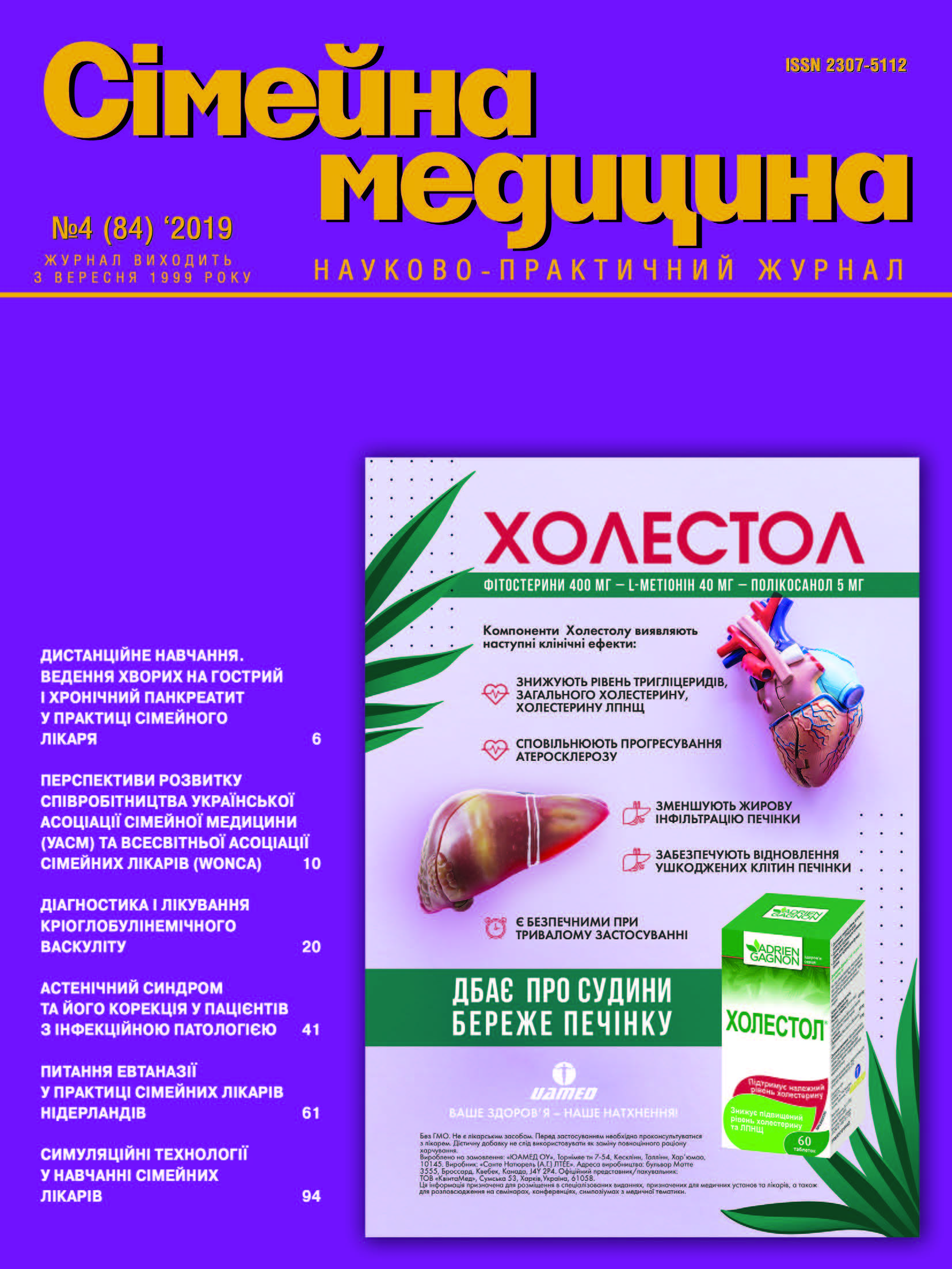Experience of Combined External Therapy of Labial Herpes
##plugins.themes.bootstrap3.article.main##
Abstract
The objective: to evaluate the effectiveness and safety of combined external use of penciclovir 1% and methyluracil 5% in the treatment of labial herpes.
Materials and methods. Under observation were 24 patients with labial herpes, aged 18 to 49 \ years, divided into 2 comparison groups. Patients of the main group every 2 hours, with the exception of the sleep period, were prescribed external therapy, including penciclovir 1% and methyluracil 5%, for 10 days. Patients of the comparison group received monotherapy with penciclovir 1% according to a similar procedure. The effectiveness of therapy was evaluated by the regression of clinical symptoms: the disappearance of subjective sensations, vesicles, erosion, the formation of a crust and complete epithelization. The safety of the proposed method of therapy was evaluated by the incidence of adverse side effects.
Results. Based on the analysis of the results of therapy, it was found that the regression of clinical manifestations in the main group occurred earlier than in the comparison group. So, in the group of patients receiving combined treatment, rashes regressed on the 3rd –6th day from the start of therapy, and in the comparison group on the 4th – 8th day of the treatment, which was due to longer periods of epithelization and discharge of the crusts. The dependence of the effectiveness of therapy on the relapse rate of labial herpes in both comparison groups was noted. Reducing the duration of rehabilitation is associated with the epithelizing effect of methyluracil. The tolerability of the proposed treatment method in all patients was satisfactory. Adverse adverse reactions during treatment were not identified.
Conclusions. The proposed method for the external treatment of labial herpes is effective and safe, helps to reduce the time of epithelization, and is well tolerated by patients.##plugins.themes.bootstrap3.article.details##

This work is licensed under a Creative Commons Attribution 4.0 International License.
Authors retain the copyright and grant the journal the first publication of original scientific articles under the Creative Commons Attribution 4.0 International License, which allows others to distribute work with acknowledgment of authorship and first publication in this journal.
References
Блатун Л.А. Местное медикаментозное лечение ран. Проблемы и новые возможности их решения / Л.А. Блатун// Consilium medicum: хирургия (прилож.). – 2007. – № 1. – С. 9–16.
Гузев К.С. Влияние мазевой основы на фармакокинетику метилурацила / К.С. Гузев, В.И. Архапчев, В.И. Ноздрин // Фармация. – 2008. – № 6. – С. 47–51.
Исаков В.А. Герпесвирусные инфекции человека: руководство для врачей / В.А. Исаков, Е.И. Архипова, Д.В. Исаков – СПб.: СпецЛит, 2013. – 670 с.
Крамарь Л.В. Герпетическая инфекция и мононуклеозоподобный синдром у детей / Л.В. Крамарь, О.А. Карпухина. – Волгоград: Изд-во ВолгГМУ, 2016. – 292 с.
Крамарь Л.В. Герпетическая инфекция у детей. Современные возможности терапии / Л.В. Крамарь, А.А. Арова, О.А. Карпухина // Лекарственный вестник. – 2010. – № 6. – С. 36–42.
Ноздрин В.И. Морфологические аспекты дерматотропного действия метилурацила в условиях накожного применения / В.И. Ноздрин, Т.А. Белоусова, А.Н. Яцковский // Морфология. – 2002. – № 122 (5). – С. 74–8.
Халдин А.А. Простой герпес: этиология, патогенез, диагностика, лечение / А.А. Халдин, Д.В. Игнатьев, А.Н. Васильев // Consilium medicum. Дерматология. – 2009. – № 1.
Cunninghama А. Current management and recommendations for access to antiviral therapy of herpes labialis / А. Cunninghama, Р. Griffiths, Р. Leonec [et al.] // J Clin Virol. – 2012. – № 53 (1). – P. 6–11.
Femiano F. Recurrent herpes labialis efficacy of topical therapy with penciclovir compared with acyclovir / F. Femiano, F. Gombos, C. Scully // Oral Diseases. – 2001. – № 7. – Р. 31–33.
Hasler-Nguyen N. Evaluation of the in vitro skin permeation of antiviral drugs from penciclovir 1% cream and acyclovir 5% cream used to treat herpes simplex virus infection / N. Hasler-Nguyen, D. Shelton, G. Ponard [et al.] // Dermatology. – BMC. – 2009. – 9:3.
Malkin J.E. Epidemiology of Herpes simplex virus infection in developed countries / J.E. Malkin // Herpes. – 2004. – Vol. 11. – Suppl. 1. – Р. 2–23.
Chayavichitsilp Р. Herpes simplex / P. Chayavichitsilp, J.V. Buckwalter, A.C. Krakowski, S.F. Friedlander // Pediatr Rev. – 2009. – Vol. 30, N 4. – Р. 119–129.
Penciclovir cream for the treatment of herpes simplex labialis. A randomized, multicenter, double-blind, placebo-controlled trial. Topical Penciclovir Collaborative Study Group / S.L. Spruance, T.L. Rea, C. Thoming [et al.] // JAMA. – 1997. – Vol. 277, N 17. – Р. 1374–1379.
Raborn G.W. Effective treatment of herpes simplex labialis with penciclovir cream / G.W. Raborn, A.Y. Martel, M. Lassonde [et al.] // JADA. – 2002. – Vol. 133. – Р. 303–309.
Schmid-Wendner M.H. Penciclovir Cream – Improved Topical Treatment for Herpes Simplex Infections / M.H. Schmid-Wendner, H.C. Korting // Skin Pharmacology and Physiology. – 2004. – Vol. 17. – Р. 214–218.





